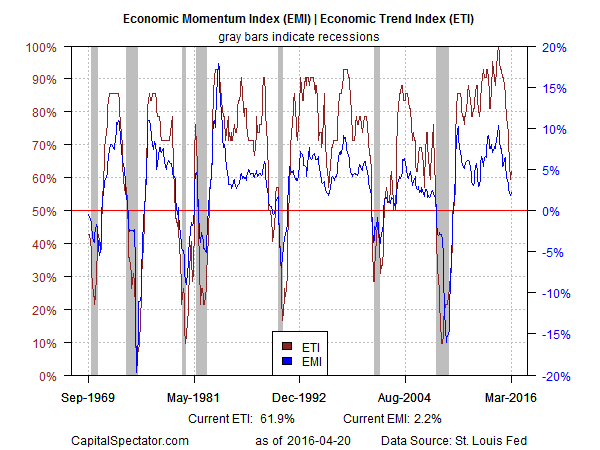Recent economic updates reveal that US growth has slowed in the first quarter, but the deceleration wasn’t sharp enough to trigger a recession, based on a broad set of numbers published through March. Estimates for first-quarter GDP suggest otherwise, but the evidence is still weak for arguing that a new downturn started last month when reviewing the data across multiple indicators from a bottom-up perspective.
The key issue going forward is how the Q2 numbers compare. The potential for even softer data can’t be ruled out, but near-term projections for the broad US trend continue to show that the economy will steer clear of a recession.
The analysis is based on a methodology outlined in Nowcasting The Business Cycle: A Practical Guide For Spotting Business Cycle Peaks. The Economic Trend and Momentum indices (ETI and EMI, respectively) have fallen in recent months but remain at levels that still equate with expansion, albeit at a relatively slow rate. Here’s a summary of recent activity for the components of ETI and EMI:
Aggregating the current data in the table above into business cycle indexes reflects weaker but still positive trends overall. The latest numbers for ETI and EMI show that both benchmarks are above their respective danger zones: 50% for ETI and 0% for EMI. Note, too, that both benchmarks have rebounded slightly in March after falling sharply in previous months. When/if the indexes fall below the tipping points, we’ll have clear warning signs that recession risk is at a critical level. (See note at the end of this post for ETI/EMI design rules.)
Translating ETI’s historical values into recession-risk probabilities via a probit model also points to low business-cycle risk for the US through last month. Analyzing the data with this methodology shows a slight uptick in risk lately, but the numbers still imply that the odds are low that the National Bureau of Economic Research (NBER) — the official arbiter of US business cycle dates— will declare March as the start of a new recession.
For another perspective, consider how ETI may evolve as new data is published. One way to project future values for this index is with an econometric technique known as an autoregressive integrated moving average (ARIMA) model, based on calculations via the “forecast” package for R, a statistical software environment. The ARIMA model calculates the missing data points for each indicator, for each month–in this case through May 2016. (Note that Jan. 2016 is currently the latest month with a complete set of published data.) Based on today’s projections, ETI is expected to remain above its danger zone for the near term by holding above the 50% mark. (Keep in mind that business cycle updates are available throughout each month in The US Business Cycle Risk Report.)
Forecasts are always suspect, of course, but recent projections of ETI for the near-term future have proven to be relatively reliable guesstimates vs. the full set of published numbers that followed. That’s not surprising, given the broadly diversified nature of ETI. Predicting individual components, by contrast, is prone to far more uncertainty in the short run. The current projections (the four black dots on the right in the chart above) suggest that the economy will continue to expand. The chart above also includes the range of vintage ETI projections published on these pages in previous months (blue bars), which you can compare with the actual data that followed, based on current numbers (red dots). The assumption here is that while any one forecast for a given indicator will likely miss the mark, the errors may cancel out to some degree by aggregating a broad set of predictions. That’s a reasonable view according to the historical record for the ETI forecasts.
For additional perspective on judging the track record of the forecasts, here are the previous updates for the last three months:
17 Mar 2016
18 Feb 2016
21 Jan 2016
Note: ETI is a diffusion index (i.e., an index that tracks the proportion of components with positive values) for the 14 leading/coincident indicators listed in the table above. ETI values reflect the 3-month average of the transformation rules defined in the table. EMI measures the same set of indicators/transformation rules based on the 3-month average of the median monthly percentage change for the 14 indicators. For purposes of filling in the missing data points in recent history and projecting ETI and EMI values, the missing data points are estimated with an ARIMA model.




Pingback: US Economic Growth Has Slowed in Q1 - TradingGods.net